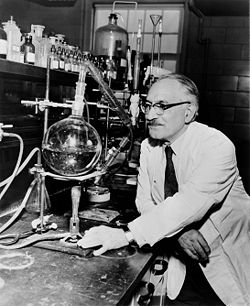Structural Biochemistry/Selman A. Waksman
Introduction
[edit | edit source]Researcher, scientist, biochemist, Selman Abraham Waksman (1888-1973) did research on soil microbes in hopes to isolate effective antibiotics. He was successful in discovering the existence and isolating antibiotic Streptomycin. In the years after that, he was able to isolate many other antibiotics that were able to treat many disease such as tuberculosis, and other infections that were resistant to Penicillin. In 1952, Waksman was awarded the Nobel Prize in Physiology or Medicine for his accomplishment in discovering streptomycin. This was considered the first antibiotic that was actively against tuberculosis. Waksman earned himself the title of "Father of Antibiotics"

Early Life
[edit | edit source]Born in 1888 in the small rural Ukrainian town of Novaya Priluka, Waksman was surrounded by fields of rich soil. Although agriculture was abundant around him, Wakman did not do much farming. However, it did plant a seed of curiosity as to what was in the soils that gave so much nutrition and even remedies that helped people. So in 1910, he did what many of his relatives were doing- move to america. Again, moving to a small town, Waksman enrolled in a small college - Rugers College, while working on a small family farm. It was during these early years that he was exposed to bacteria, as he started working in a lab. Getting introduced to such cultures such as the actinomycetes, his interest in microbes in the soil was growing. Watksman graduated with a Bachelor of Science in Agriculture.
In 1918, Watkins received his Ph. D in Biochemistry from the University of California, Berkeley, and returned to Rutger's University where he continued to research on microflora.
Research and Discovery
[edit | edit source]Inspired by a fellow researcher, Rene Dubois, who worked in his laboratory and isolated soil bacterium, Streptococcus pneumoniae, Waksman was motivated to look beyond the pre-existing antibacterial organisms. So he and his team structured their research so as to inhibit zones of colones that isolated soil microbes. These were grown under many different conditions and tested. After many test and trials, Waksman and his team isolated Actinomyces antibioticus, which was part of the actinomycetes family. But soon it was found that the actinomycin that was excreted was extremely toxic to the experimental organisms.
His research did not stop here, he continued until finally in 1944, he was able to discover the existence of streptomycin. This along with more than 20 new substances (that includes neomycin) were isolated. It was Waksman that coined the term "antibiotics" along the path of his research for inhibitors of natural growth.

References
[edit | edit source]1. http://www.jbc.org/content/279/48/e7.full
2. Waksman, S. A., and Woodruff, H. B. (1940) The soil as a source of microorganisms antagonistic to disease-producing bacteria. J. Bacteriol.
3. Trial, Richelle. UCSD Bacteriology (Bimm 120) Lecture 10/30/2012 "Bacterial Development"
